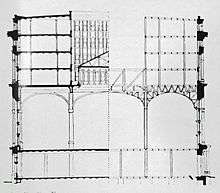New York Produce Exchange
The New York Produce Exchange was a produce exchange at Bowling Green in Lower Manhattan, New York City. It was founded in 1861, and served a network of produce and commodities dealers across the United States.[1] In the 1880s, it had the largest membership of any stock exchange in the United States.[2]
 | |
| Type | Commodities exchange |
|---|---|
| Location | New York City, United States |
| Founded | 1861 |
| Currency | USD |
The exchange's structure was the first building in the world to combine wrought iron and masonry in its structural construction.[3] It was demolished in 1957 to make way for a skyscraper called 2 Broadway.[1]
History
_pg801_NEW-YORK_PRODUCE_EXCHANGE.jpg)
The produce exchange was founded in 1861, and served a network of produce and commodities dealers across the United States. In 1881, the exchange began building a structure that The New York Times later called "the most impressive exchange structure ever seen in Manhattan." The bid for the project went to George Browne Post. Explains the Times: "for the 150- by 300-foot site, Post built an arcaded fortress, as noble as anything in Florence, but in fiery red brick. Post made more than 4,000 drawings for the exchange, which he gave a 144-by-220-foot trading floor 60 feet high, with an off-center tower rising to 224 feet." Finished in 1884,[1] it stood on Bowling Green and was the first building in the world to combine wrought iron and masonry in its structural construction.[3]
By 1885, the New York Produce Exchange had the largest membership of any exchange in the United States, with the Consolidated Stock Exchange of New York directly underneath with membership of 2403.[2] In 1886, the trading in the building was described as "callithumpian discord" with "fiendish screeches" by Harper's New Monthly Magazine. The building at that point had amenities for buyers and sellers, had lounges, a restaurant, meeting halls, offices that could be rented, and a library. In the 1880s, membership was around 2,500. By 1900, the exchange was doing $15 million a day in business.[1]
After approval from the Controller of the Currency the day before, on June 21, 1920, Mechanics and Metals National Bank and the Produce Exchange Union were merged. With branches in Manhattan and a main office at 20 Nassau Street, the new consolidated institution was named Mechanics and Metals National Bank. Combined capital, surplus, and profits of the new bank were approximated at $25,000,000, with deposits exceeding $200,000,000.[4]
Membership had fallen to 500 by the 1950s. In 1953, the exchange moved to a new office building designed by William Lescaze.[1] The Produce Exchange Building was demolished in 1957[1] and replaced by a 32-story tower constructed in 1958–1959, named 2 Broadway.[5]
Gallery
 Structural design of the NY Produce Exchange.
Structural design of the NY Produce Exchange..tiff.jpg) Interior in 1880
Interior in 1880_pg802_PRODUCE_EXCHANGE%2C_INTERIOR_OF_MAIN_FLOOR.jpg) Interior of main floor, published 1893
Interior of main floor, published 1893_pg134_ELEVATED_RAILROAD%2C_AT_COENTIES_SLIP%2C_PRODUCE_EXCHANGE_TOWER.jpg) View of the building tower from a nearby railroad
View of the building tower from a nearby railroad.jpg) Custom House statue- in rear of N.Y. Produce Exchange Building, July 23, 1936
Custom House statue- in rear of N.Y. Produce Exchange Building, July 23, 1936.tiff.jpg) View of the exterior
View of the exterior
See also
References
- Gray, Christopher (August 21, 2014). "A Brick Beauty Bites the Dust". The New York Times. Retrieved December 23, 2013.
- The Consolidated Stock Exchange of New York: Its History, Organization, Machinery and Methods. 1907.
- Stern, Robert A. M.; Gilmartin, Gregory; Massengale, John M. (1983). New York 1900: Metropolitan Architecture and Urbanism, 1890-1915. Rizzoli International Publications. p. 146. ISBN 0-8478-0511-5.
- "Bank Merger is Approved; Mechanics and Metals and Produce Exchange Union Effective Today". The New York Times. June 21, 1920. Retrieved February 27, 2017.
- "2 Broadway". Nyc-architecture.com.
External links
